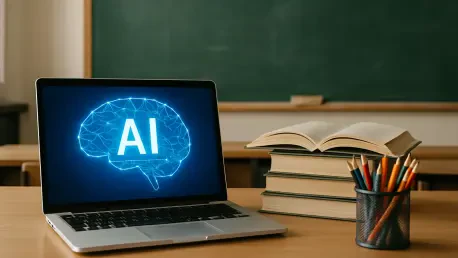I’m thrilled to sit down with Camille Faivre, a renowned expert in education management who has been at the forefront of transforming learning environments in the post-pandemic era. With her deep focus on open and e-learning programs, Camille has guided countless institutions in navigating the complexities of digital education and emerging technologies like AI. In this interview, we dive into the rapid rise of AI in classrooms, the ethical challenges it brings, the growing demand for digital learning, equity gaps in access to technology, and how schools can better prepare students for life beyond academics. Let’s explore her insights on shaping the future of education.
How has the integration of AI tools evolved in educational settings over the past year, and what changes have you noticed in how students and teachers engage with them?
I’ve seen a remarkable surge in AI adoption in schools over the past year. Both students and teachers are increasingly turning to these tools for a variety of tasks, from research to creating study materials. What’s particularly striking is the shift in who’s leading the charge—teachers are now often outpacing students in using AI, which wasn’t the case just a short while ago. This reflects a growing comfort with the technology among educators, who are finding innovative ways to enhance their teaching. Students, meanwhile, are leveraging AI to streamline learning, like summarizing complex topics or generating study guides.
What do you believe is fueling this growing reliance on AI in education, especially among teachers?
Several factors are driving this trend. For teachers, AI offers a way to save time on tasks like lesson planning or creating assessments, allowing them to focus more on direct student interaction. There’s also a broader cultural shift toward accepting technology as a core part of education, especially post-pandemic, when digital tools became essential. Additionally, professional development opportunities are helping educators become more confident in using AI, which encourages adoption. It’s a mix of necessity, efficiency, and a push for innovation that’s propelling this forward.
Can you share some specific ways AI is being used to support learning, such as in research or developing classroom resources?
Absolutely. In many schools, AI is being used to summarize large volumes of information for research projects, making it easier for students to grasp key concepts quickly. Teachers are also using it to generate customized quizzes, worksheets, or even full lesson plans tailored to their students’ needs. I’ve seen cases where AI helps create accessible materials for students with diverse learning requirements, like converting text to speech or simplifying content. These applications not only save time but also enhance the quality and personalization of education.
There seems to be a significant gap in how students and teachers perceive the ethical use of AI in the classroom. Why do you think students are more skeptical about this compared to educators?
This gap often comes down to perspective and experience. Teachers, who are often guided by institutional policies or training, tend to view AI as a tool they can control and use responsibly. Students, on the other hand, might worry about issues like fairness—whether AI grading is unbiased, for instance—or they might feel pressure to use it in ways that could border on academic dishonesty. There’s also a lack of open dialogue in many schools about what ethical AI use looks like, which can leave students feeling uncertain or mistrustful.
What practical steps can schools take to ensure AI is used responsibly and equitably across the board?
Schools need to start with clear policies on AI use that are communicated to everyone—students, teachers, and parents. This includes defining acceptable uses and consequences for misuse. Training is also crucial; both students and educators should learn not just how to use AI, but why certain boundaries exist. I also think fostering a culture of transparency, where students can voice concerns about AI tools, is key. Finally, schools should regularly evaluate the AI tools they adopt to ensure they don’t perpetuate bias or inequity.
Have you encountered any effective training programs or guidelines that help build a shared understanding of ethical AI use in education?
Yes, I’ve seen some promising initiatives. Some districts have rolled out workshops that bring students and teachers together to discuss AI’s role in learning, covering topics like data privacy and academic integrity. There are also online modules developed by educational organizations that offer practical scenarios to teach responsible use. What works best is when these programs are ongoing, not just one-off sessions, and when they involve real-world examples that resonate with the school community. These efforts help demystify AI and build trust.
Digital learning is gaining traction, with many advocating for it to match or exceed traditional methods. What’s behind this rising popularity?
Digital learning’s appeal lies in its adaptability. It offers flexibility in terms of when and where students can learn, which is a huge draw for busy families or students with unique schedules. It also allows for personalized experiences—think adaptive platforms that adjust to a student’s pace or learning style. Post-pandemic, there’s a heightened awareness of how technology can keep education accessible during disruptions. Plus, as digital natives, today’s students are often more comfortable with online tools, which makes this shift feel natural.
How do the advantages of digital learning, like flexibility and personalization, translate into tangible benefits for students’ everyday academic lives?
These benefits make a real difference. Flexibility means a student can revisit a recorded lesson at midnight if that’s when they focus best, or catch up on missed classes without falling behind. Personalization allows struggling students to get extra practice on tough topics while advanced learners can dive deeper without waiting for the class to catch up. I’ve seen students gain confidence because they’re learning at their own pace, and it reduces stress by letting them balance school with other responsibilities more effectively.
With so many students sacrificing sleep or activities due to homework, how can digital learning help alleviate these pressures?
Digital learning can be a game-changer here. Tools like automated study planners or platforms that break down assignments into manageable chunks help students manage their time better. Online resources also mean they can get quick help without staying up late searching for answers. I’ve seen schools use digital systems to streamline homework, focusing on quality over quantity, which cuts down on unnecessary workload. When used thoughtfully, these tools can free up time for rest or extracurriculars, creating a healthier balance.
Access to digital learning tools isn’t equal for everyone, especially for students with learning differences. What are some of the major barriers you’ve observed in ensuring equitable access?
One big barrier is simply the availability of devices and reliable internet—many families still can’t afford them, and rural areas often lack connectivity. For students with learning differences, the challenge is also about having the right software or assistive tech, which isn’t always provided or compatible with school systems. There’s also a gap in teacher training; not all educators know how to adapt digital tools for diverse needs. These issues create a divide where some students are left struggling to keep up through no fault of their own.
What strategies can schools and policymakers adopt to bridge this equity gap in digital learning access?
Schools and policymakers need to prioritize funding for tech infrastructure—think subsidies for devices or expanding broadband in underserved areas. Partnerships with tech companies can also help provide discounted or free tools. Beyond hardware, there should be investment in training teachers to use inclusive digital platforms effectively. I also believe in community-based solutions, like setting up tech hubs in libraries or schools for shared access. It’s about creating a system where no student is excluded due to resources or location.
Are there any standout programs or initiatives you’ve seen that are successfully tackling these access disparities?
Yes, I’ve come across some inspiring efforts. Certain school districts have launched one-to-one device programs, ensuring every student gets a laptop or tablet, often with internet hotspots for home use. There are also nonprofit initiatives that refurbish old devices and distribute them to low-income families. Some regions have created accessibility task forces that specifically focus on students with disabilities, providing tailored tech and support. These programs show that with targeted action, it’s possible to make significant progress in leveling the playing field.
Many feel that schools aren’t doing enough to prepare students for life after graduation. How can education systems better equip students for real-world success?
Schools need to shift focus beyond just academic content to life skills. This means integrating things like financial literacy, critical thinking, and mental health strategies into the curriculum. I’ve seen success with project-based learning that mimics real-world challenges, like budgeting a household or solving community issues. Career-connected learning, such as internships or mentorships, also helps students see the link between education and future goals. It’s about teaching them how to adapt and thrive, not just memorize facts.
What is your forecast for the future of AI and digital learning in education over the next decade?
I believe we’re on the cusp of a transformative decade. AI will likely become even more embedded in education, personalizing learning to an unprecedented degree and automating more administrative tasks for teachers. Digital learning will continue to grow, potentially blurring the lines between traditional and online education as hybrid models become the norm. However, the challenge will be ensuring equity and ethical use remain at the forefront. If we can address those, I see a future where technology empowers every learner to reach their full potential, no matter their background or circumstances.









